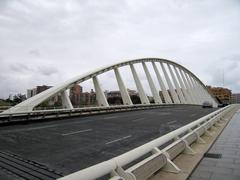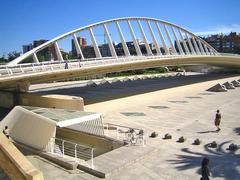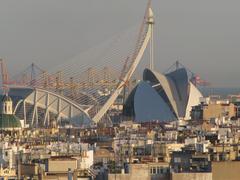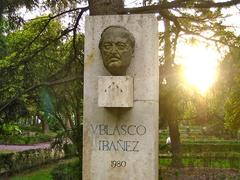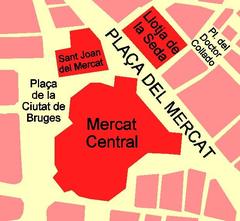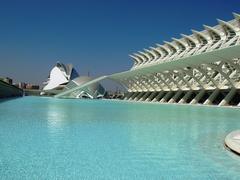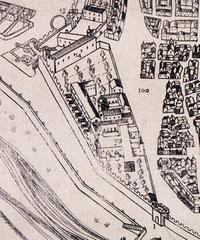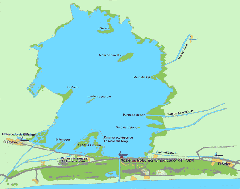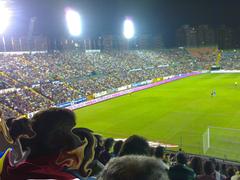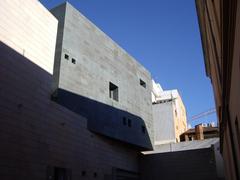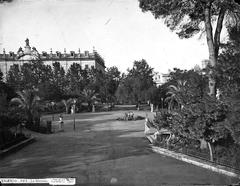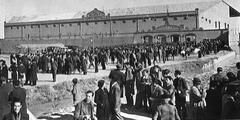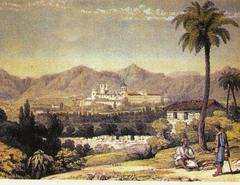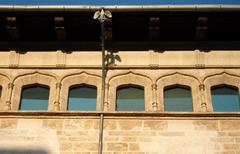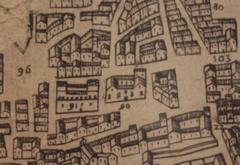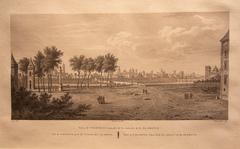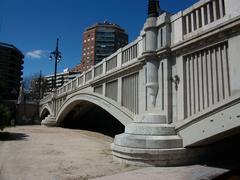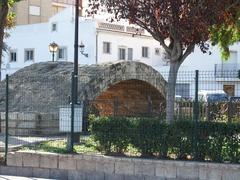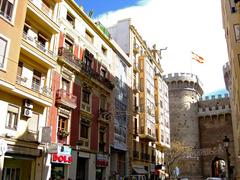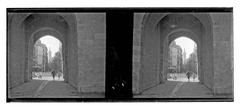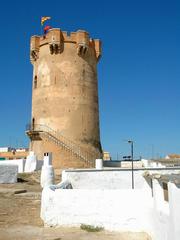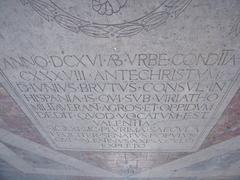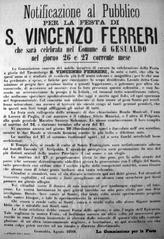
Pont de l’Exposició Visiting Hours, Tickets, and Historical Insights
Date: 23/07/2024
Introduction
The Pont de l’Exposició, also known as the ‘Exhibition Bridge’ or colloquially referred to as ‘La Peineta,’ stands as a testament to modern architectural brilliance in Valencia, Spain. Designed by the esteemed Valencian architect Santiago Calatrava, the bridge is not merely a functional piece of infrastructure but a symbol of the city’s commitment to innovation and design. Spanning the former Turia River, now transformed into the lush Turia Gardens, the Pont de l’Exposició connects Valencia’s historic center with the avant-garde City of Arts and Sciences, another of Calatrava’s masterpieces. This guide delves into the bridge’s history, architectural significance, visiting information, and tips for making the most of your visit, ensuring a comprehensive understanding of this iconic landmark (Valencia City Guide, Architectural Digest).
Table of Contents
- Introduction
- History of Pont de l’Exposició
- Architectural Significance
- Visiting Information
- Travel Tips and Nearby Attractions
- Cultural and Social Impact
- Preservation and Maintenance
- Public Reception and Criticism
- Role in Urban Development
- Future Prospects
- FAQ
- Conclusion and Call to Action
History of Pont de l’Exposició
Origins and Construction
The Pont de l’Exposició was designed by Santiago Calatrava, a Valencian architect celebrated for his futuristic and organic designs. Construction began in 1991 and was completed in 1995, as part of a broader urban renewal project aimed at revitalizing the Turia Riverbed, which had been transformed into a sprawling park after a catastrophic flood in 1957 led to the river being diverted (Valencia City Guide).
Historical Context
The bridge’s construction coincided with a period of significant transformation in Valencia. The city was preparing to host the 1992 Universal Exposition, which brought international attention and investment. The Pont de l’Exposició was one of several infrastructure projects undertaken to modernize the city and improve its connectivity (Valencia History).
Architectural Significance
Design and Structure
The Pont de l’Exposició is a prime example of Calatrava’s distinctive style, characterized by its sleek, white, and sculptural form. The bridge spans 131 meters and is supported by a single, inclined pylon that rises 125 meters above the ground. This pylon is connected to the bridge deck by a series of steel cables, creating a harp-like appearance. The design ensures the structural integrity of the bridge, allowing it to withstand the dynamic loads imposed by pedestrian and vehicular traffic (ArchDaily).
Visiting Information
Visiting Hours and Tickets
The Pont de l’Exposició is accessible to the public 24/7, and there is no admission fee. However, guided tours are available for those interested in a more in-depth understanding of the bridge’s architecture and history. These tours typically run from 10 AM to 6 PM. For the latest information on guided tours and ticket prices, visit the official website.
How to Get There
The bridge is conveniently located near the city center and is easily accessible by public transportation. The nearest metro station is Alameda, which is a short walk from the bridge. Buses and taxis are also readily available throughout the city.
Accessibility
The Pont de l’Exposició is designed to be accessible to all visitors, including those with disabilities. Ramps and elevators are available to ensure that everyone can enjoy the bridge and its surroundings.
Travel Tips and Nearby Attractions
When visiting the Pont de l’Exposició, consider exploring the nearby Turia Riverbed park, which offers beautiful walking paths, gardens, and recreational areas. Other attractions in the vicinity include the City of Arts and Sciences, the Valencia Cathedral, and the Central Market.
Best Time to Visit
Valencia enjoys a Mediterranean climate, making it a year-round destination. However, the best time to visit the Pont de l’Exposició is during the spring (March to May) and fall (September to November) when the weather is pleasant, and the city is less crowded. During these periods, temperatures range from 15°C to 25°C (59°F to 77°F), providing a comfortable environment for walking and sightseeing (Valencia Weather).
Safety Tips
- Pedestrian Safety: The bridge has designated pedestrian lanes, but it’s essential to stay alert as cyclists also use the bridge.
- Weather Precautions: Valencia can get quite hot in the summer, so carry water, wear sunscreen, and use a hat or umbrella for shade.
- Pickpocketing: Like any tourist spot, be mindful of your belongings. Keep your valuables secure and be aware of your surroundings.
Photography Tips
The Pont de l’Exposició offers numerous opportunities for stunning photographs:
- Golden Hour: Visit during sunrise or sunset to capture the bridge bathed in golden light.
- Night Photography: The bridge is beautifully illuminated at night, making it an excellent subject for night photography.
- Angles and Perspectives: Experiment with different angles and perspectives. The bridge’s unique design can be captured from various points in the Turia Gardens or from the City of Arts and Sciences.
Cultural and Social Impact
Since its completion, the Pont de l’Exposició has become an iconic symbol of Valencia’s modernity and architectural innovation. It is frequently featured in promotional materials and has been the subject of numerous architectural studies and publications. The bridge’s striking design has also made it a popular backdrop for cultural events, photo shoots, and film productions (Architectural Digest).
Preservation and Maintenance
Maintaining the Pont de l’Exposició is a priority for the city of Valencia. Regular inspections and maintenance work are carried out to ensure the bridge remains in optimal condition. The bridge’s maintenance is overseen by the city’s Department of Public Works, which collaborates with engineering firms to address any issues that arise (Valencia Public Works).
Public Reception and Criticism
While the Pont de l’Exposició is widely admired for its design, it has not been without controversy. Some critics argue that the bridge’s construction prioritized high-profile architectural projects over more pressing urban needs, such as affordable housing and public transportation. The bridge’s maintenance costs have also been a point of contention, with some residents questioning the allocation of public funds for its upkeep (Urban Studies Journal).
Role in Urban Development
The Pont de l’Exposició has played a pivotal role in Valencia’s urban development. It has improved connectivity between different parts of the city, facilitating economic growth and urban expansion. The bridge has also contributed to the transformation of the Turia Riverbed into a vibrant public space, attracting both locals and tourists (Valencia Urban Planning).
Future Prospects
Looking ahead, the Pont de l’Exposició is expected to continue serving as a vital piece of Valencia’s infrastructure. Plans are in place to enhance the bridge’s integration with the city’s public transportation network, including the addition of dedicated bike lanes and improved pedestrian access. These initiatives aim to promote sustainable mobility and reduce traffic congestion in the city center (Valencia Tourism Board).
FAQ
Q: What are the visiting hours for the Pont de l’Exposició? A: The bridge is accessible 24/7, but guided tours are available from 10 AM to 6 PM.
Q: Is there an admission fee to visit the Pont de l’Exposició? A: There is no admission fee, but guided tours may have a cost.
Q: How do I get to the Pont de l’Exposició? A: The nearest metro station is Alameda. Buses and taxis are also available.
Q: What nearby attractions should I visit? A: Nearby attractions include the Turia Riverbed park, City of Arts and Sciences, Valencia Cathedral, and Central Market.
Q: Is the Pont de l’Exposició accessible for visitors with disabilities? A: Yes, the bridge is designed to be accessible to all visitors.
Conclusion and Call to Action
The Pont de l’Exposició stands as a testament to Valencia’s commitment to architectural excellence and urban innovation. Its history is intertwined with the city’s broader narrative of transformation and modernization. As Valencia continues to evolve, the bridge will undoubtedly remain a key feature of its urban landscape. For the latest updates and more information on visiting Valencia’s historical sites, follow us on social media or visit our website (Valencia Public Works, Valencia Tourism Board).
References
- Valencia City Guide. Pont de l’Exposició - Visiting Hours, Tickets, and Architectural Marvel of Valencia. Retrieved from https://www.valenciacityguide.com.
- Valencia History. Pont de l’Exposició - Visiting Hours, Tickets, and Architectural Marvel of Valencia. Retrieved from https://www.valenciahistory.com.
- ArchDaily. Pont de l’Exposició - Visiting Hours, Tickets, and Architectural Marvel of Valencia. Retrieved from https://www.archdaily.com.
- Valencia Public Works. Pont de l’Exposició - Visiting Hours, Tickets, and Architectural Marvel of Valencia. Retrieved from https://www.valenciapublicworks.com.
- Urban Studies Journal. Pont de l’Exposició - Visiting Hours, Tickets, and Architectural Marvel of Valencia. Retrieved from https://www.urbanstudiesjournal.com.
- Valencia Urban Planning. Pont de l’Exposició - Visiting Hours, Tickets, and Architectural Marvel of Valencia. Retrieved from https://www.valenciaurbanplanning.com.
- Valencia Tourism Board. Pont de l’Exposició - Visiting Hours, Tickets, and Architectural Marvel of Valencia. Retrieved from https://www.valenciatourismboard.com.
- Visit Valencia. Pont de l’Exposició - A Guide to Valencia’s Iconic Bridge. Retrieved from https://www.visitvalencia.com/en/what-to-do-valencia/architecture/bridges/pont-de-lexposicio.
- Structurae. Pont de l’Exposició - A Guide to Valencia’s Iconic Bridge. Retrieved from https://structurae.net/en/structures/pont-de-l-exposicio.
- City of Arts and Sciences. Pont de l’Exposició - A Guide to Valencia’s Iconic Bridge. Retrieved from https://www.cac.es/en/home.html.
- Metrovalencia. Pont de l’Exposició - A Guide to Valencia’s Iconic Bridge. Retrieved from https://www.metrovalencia.es/page.php.
- Palau de la Música. Pont de l’Exposició - A Guide to Valencia’s Iconic Bridge. Retrieved from https://www.palauvalencia.com.
- Gulliver Park. Pont de l’Exposició - A Guide to Valencia’s Iconic Bridge. Retrieved from https://www.visitvalencia.com/en/what-to-do-valencia/with-children/gulliver-park.
- Turia Gardens. A Comprehensive Guide to Visiting Pont de l’Exposició in Valencia - Tips, Attractions, and More. Retrieved from https://www.visitvalencia.com/en/what-to-do-valencia/parks-gardens/turia-gardens.
- Valencia Weather. A Comprehensive Guide to Visiting Pont de l’Exposició in Valencia - Tips, Attractions, and More. Retrieved from https://www.weather.com/weather/today/l/Valencia+Spain.
- Valencia City Council. A Comprehensive Guide to Visiting Pont de l’Exposició in Valencia - Tips, Attractions, and More. Retrieved from https://www.valencia.es/.
